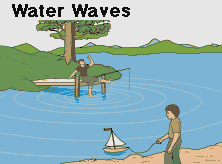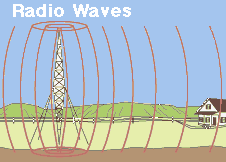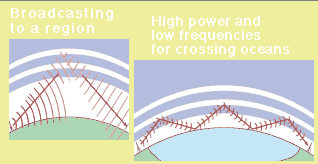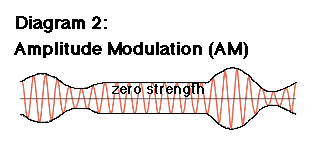FM Radio Transmission





|
| ||
|
| Radio waves are a type of electromagnetic wave. Since it is a wave, we can make an analogy between radio waves and water waves. The figure at the left shows a scenerio where water waves propogate from a single center point by the a ction of tossing a rock into the water. Radio waves cause electrons in an antenna to surge back and forth the same way that the ripples in a pond case the the water to move up and down. Unlike water waves, radio waves travel at the speed of light (186,000 miles per second). " | |
|
| Just like light waves, radio waves travel in straight lines. Radio waves can reflect off of surfaces, such as layers of ionized gases in the ionosphere. Radio waves reflect off of surfaces the same way that water waves do. The reflection of radio waves is shown in the figure below. Here, radio waves are reflected off of the ionosphere and the Earth. Radio waves, however are not shaped like the circular water waves. Radio waves typically are domed shaped as shown in the picture to the right. These domed-shaped waves radiate from a transmitting antenna in all directions. Waves of different wavelenghts can cross or even travel along the same lines without interfering with the others. This allows several waves to exist at the same time - all at different frequencies. It is the job of the receiver to tune into a specific frequency and ignore all radio signals at other frequencies. |
|
|
| ||
| The sound that humans here is caused by vibrations in air. If a sound is loud, the vibration will be large, if the sound is soft, the vibration will be small. This is shown in the figure above. The changing magnitude and the frequency of the wave shown above is what actually carries sound information to the human ear. The human ear can hear sounds in the range from 20Hz to 20,000Hz, where the unit Hz is used to indicate the frequency of the sound wave. A really deep sound will have a low frequency and a really high-pitched sound will have a high frequency. These small frequency waves cannot be transmitted. These audio frequency waves must somehow be changed in order to be transmitted. The two methods of doing this are frequency modulation (FM) and amplitude modulation (AM). |
Amplitude modulation was the first radio transmission method.
Amplitude
modulation works by creating a signal which is has a constant frequency at
whatever radio frequency you want to broadcast at (1Mhz for example). The
amplitude of the wave is then changed according to the strength of the signal
being broadcasted.
| |
| Frequency Modulation is the most popular radio transmission technique used today. FM is so popular because it is able to transmit more of the sound that we want to here. AM has problems in transmitting sounds which are at higher frequencies, such as those created by a flute. Frequency modulation works by first creating a signal at the desired carrier frequency (107.7Mhz for example). Then the varying sound level causes frequency changes - The louder the sound, the frequency of the carrier wave increases. Frequency modulation is shown in the figure below. An important factor in FM is that the carrier signal has a constant amplitude. |
| |
Ham radio Data Center - free schematics | Free HAM Directory | About me | Acronyms | CW | Data Sheets | Docs | Download | E-mail | HOME | Ham projects | Hobby circuits | Photo galery | PIC | QTH photos |
Sign in my guestbook | View my guestbook ]
� 2001 - YO5OFH, Csaba Gajdos